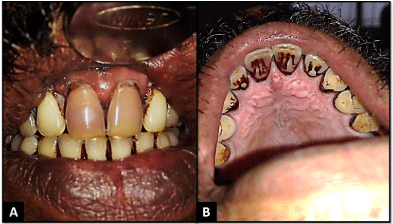
Clinical Image
J Dent & Oral Disord. 2017; 3(4): 1070.
The Pink Teeth: A Case of Internal Resorption of Teeth
Pauly G*, Kashyap RR, Kini R, Rao PK and Bhandarkar GP
Department of Oral Medicine and Radiology, A J Institute of Dental Sciences, India
*Corresponding author: Geon Pauly N, Department of Oral Medicine and Radiology, A J Institute of Dental Sciences, Kuntikana, Mangaluru, Karnataka, India
Received: July 18, 2017; Accepted: July 24, 2017; Published: July 31, 2017
Keywords
Pink teeth; Tooth fracture; Intra-oral radiograph
Clinical Image
A 35-year-old male patient reported to our department with a chief complaint of discolored upper front teeth since 2-3 years. He gave a history of a minor trauma to the teeth 3 years back, post which no dental treatment was undertaken. There was no episode of pain or any other associated discomfort. His medical history was non-contributory. He was an avid tobacco chewer. On clinical examination, tooth 11, 21 were discolored giving it a generalized pinkish-yellowish hue with presence of extrinsic stains, prominently on the lingual aspect. Neither fracture nor dentinal caries were evident in relation to the concerned teeth [Figure 1]. No swelling, sinus tract or erythema was detected. The vertical and the axial percussions were unproductive. A provisional diagnosis of internal resorption of tooth was given based on patient’s history and clinical picture and an intra-oral radiograph confirmed the same. Patient was referred for endodontic evaluation of the affected teeth.

Figure 1: Internal resorption i.r.t. to 11, 21 giving it a clinical ‘pink’ tooth
appearance: A – Labial view; B – Lingual view.
Tooth resorption is defined as a condition associated with either a physiologic or a pathologic process resulting in loss of enamel, dentin, cementum or bone. It can be broadly classified as: external and internal resorption. Internal resorption is described as a resorptive defect of the internal aspect of the root with formation of granulation tissue or deposition of metaplastic tissue as a result of chronic inflammation and bacterial invasion of the pulp tissue [1]. Teeth in which resorptive process reaches cervical area of the crown may have a pinkish color, known as ‘‘pink tooth’ resulting from granulation tissue ingrowth [2]. Internal root resorption can be either transient or progressive according to a study by Wedenberg et al. [3]. The early diagnosis and therapy is very important in order to stop the resorption process. The outcome of treatment of teeth with internal root resorption depends primarily on the size of the lesion. Large lesions cause a reduction in the resistance of the tooth to shear forces that may lead to tooth fracture. Therefore, it is imperative to initiate endodontic treatment as soon as possible to arrest the progression of the resorptive process and to prevent root or cervical crown fracture [4].
References
- Patil P, Pimpale S, Mandwe A, Ricchawal A, Kiswe S. Pink Tooth –Diagnosis & Management- A Case Report. Asian Pac J Health Sci. 2015; 2: 1-5.
- Maria R, Mantri V, Koolwal S. Internal resorption: a review & case report. Endodontology. 2010; 22: 100-108.
- Wedenberg C, Lindskog S. Experimental internal resorption in monkey teeth. Endod Dent Traumatol. 1985; 1: 221-227.
- Patel N, Vachhani K, Sonigra H, Attur K, Patel A, Asnani M. The Pink Tooth: Unknown Etiology with Known Consequences. Sch J Dent Sci. 2015; 2:122- 125.